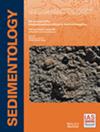碳酸盐古环境-古气候意义及沉积动力学的新认识Lagerstätten:意大利南部Pietraroja下Albian
IF 2.8
2区 地球科学
Q1 GEOLOGY
引用次数: 0
摘要
摘要:本文报道了首次对Albian Pietraroja Lagerstätten(亚平宁碳酸盐岩台地)的高分辨率综合相分析,该台地发现了意大利最早的恐龙(samniticus Scipionyx)以及其他陆生脊椎动物和植物。为了澄清长期争论的Pietraroja演代的古环境意义,进行了以下工作:(i)实地调查,以确定化石Lagerstätten的地层位置和数量;(ii)对一个新剖面进行厘米尺度的相分析,该剖面厚约15米,由两个新的岩石地层单元组成,即“旋回组织灰岩”和“彻蒂灰岩”;(iii)扫描电子显微镜-能量色散X射线能谱和背散射电子-能量色散X射线能谱分析古气候和非碳酸盐颗粒的粘土矿物代用品;(iv)对化石Lagerstätten的区域和超区域事件地层背景进行调查,以阐明其形成的控制因素。该部分包括三个观测到的富含化石的Lagerstätten中的两个,每个厚达1.5米。岩相的排列和早期成岩叠印确定了浅水沉积旋回,暗示了旋进和短偏心周期。中部Lagerstätte产西皮onyx samniticus由三个间隔组成。下部的滨水层是在干旱条件下沉积的,并逐渐过渡到上部的植物丰富的滨海湿地碳质泥灰岩。“Cherty石灰石”,产有陆生脊椎动物的Lagerstätte上部,包含两个细刺状间隔,表明在一个浅的、受限的泻湖中发育了硅质海绵草甸。成因地层学表明,Pietraroja Lagerstätten形成于冰川期低洼;有趣的是,中部Lagerstätte反映了最早的Albian海平面低洼(KAl1事件,约111.2迈尔),在半连续的风吹火山碎屑供应期间。本文的研究结果证实了顺陆Lagerstätten在从碳酸盐台地档案中推导出高频古气候动力学和冰川冰蚀过程中的关键作用。讨论了在阿普提亚晚期-阿普提亚早期寒期连接非洲和欧洲的特提斯大陆桥的起源。本文章由计算机程序翻译,如有差异,请以英文原文为准。
New insights into the palaeoenvironmental–palaeoclimatic significance and sedimentary dynamics of carbonate Lagerstätten: The Lower Albian of Pietraroja (Southern Italy)
ABSTRACT This study reports the first high‐resolution, integrated facies analysis of the lowermost Albian Pietraroja Lagerstätten (Apennine Carbonate Platform) which yields the first dinosaur ( Scipionyx samniticus ) found in Italy and other terrestrial vertebrates and plants. Aiming to clarify the long‐debated palaeoenvironmental significance of the Pietraroja succession, the following have been carried out: (i) a field survey to establish stratigraphic position and number of the fossil Lagerstätten; (ii) the centimetre‐scale facies analysis of a new section, ca 15 m‐thick, consisting of two new lithostratigraphic units, the ‘Cyclically organized Limestones’ and the ‘Cherty Limestones’ ; (iii) the scanning electron microscopy – energy dispersive X‐ray spectroscopy and backscattered electron – energy dispersive X‐ray spectroscopy analyses of clay mineral proxies for palaeoclimate and non‐carbonate grains; and (iv) the regional and supra‐regional investigation of the event stratigraphical context of the fossil Lagerstätten, in order to elucidate the controls on their formation. The section includes two out of the three observed fossil‐rich Lagerstätten, each up to 1.5 m‐thick. The arrangement of lithofacies and early diagenetic overprint defines shallow‐water depositional cycles suggestive of precession and short‐eccentricity periodicities. The Middle Lagerstätte yielding Scipionyx samniticus consists of three intervals. The lower, paralic interval was deposited during arid conditions and passes gradually to the plant‐rich, coastal wetland carbonaceous marls of the upper interval. The ‘ Cherty Limestones’ , yielding the Upper Lagerstätte with terrestrial vertebrates, contains two spiculitic intervals suggesting the development of siliceous sponge meadows in a shallow, restricted lagoon. Genetic stratigraphy suggests that the Pietraroja Lagerstätten were formed during glacioeustatic lowstands; interestingly, the Middle Lagerstätte mirrors the earliest Albian sea‐level lowstand (KAl1 event, ca 111.2 Myr), during a semi‐continuous supply of windblown volcaniclastics. Findings herein substantiate the pivotal role of paralic‐continental Lagerstätten for deriving high‐frequency palaeoclimatic dynamics and glacioeustacy from carbonate platform archives. The origin of Tethyan continental bridges between Africa and Europe during the late Aptian–earliest Albian cold interval is discussed.
求助全文
通过发布文献求助,成功后即可免费获取论文全文。
去求助
来源期刊

Sedimentology
地学-地质学
CiteScore
8.20
自引率
11.40%
发文量
94
审稿时长
6-12 weeks
期刊介绍:
The international leader in its field, Sedimentology publishes ground-breaking research from across the spectrum of sedimentology, sedimentary geology and sedimentary geochemistry.
Areas covered include: experimental and theoretical grain transport; sediment fluxes; modern and ancient sedimentary environments; sequence stratigraphy sediment-organism interaction; palaeosoils; diagenesis; stable isotope geochemistry; environmental sedimentology
 求助内容:
求助内容: 应助结果提醒方式:
应助结果提醒方式:


